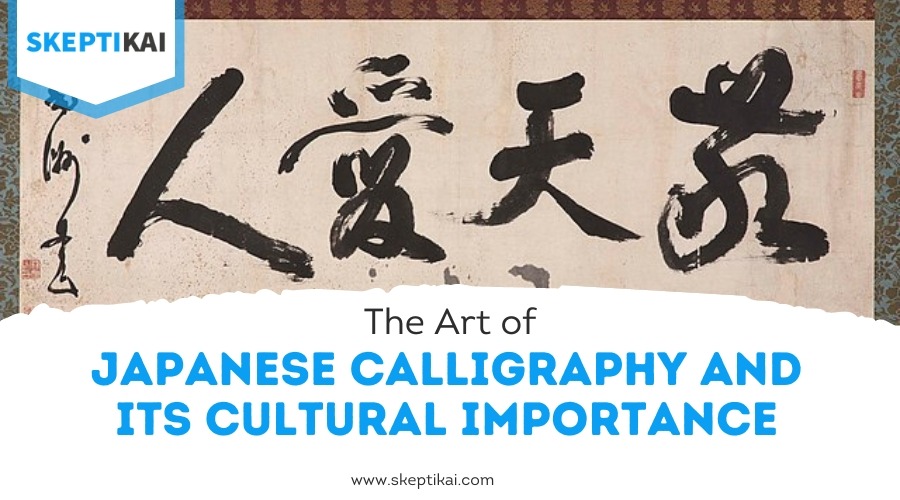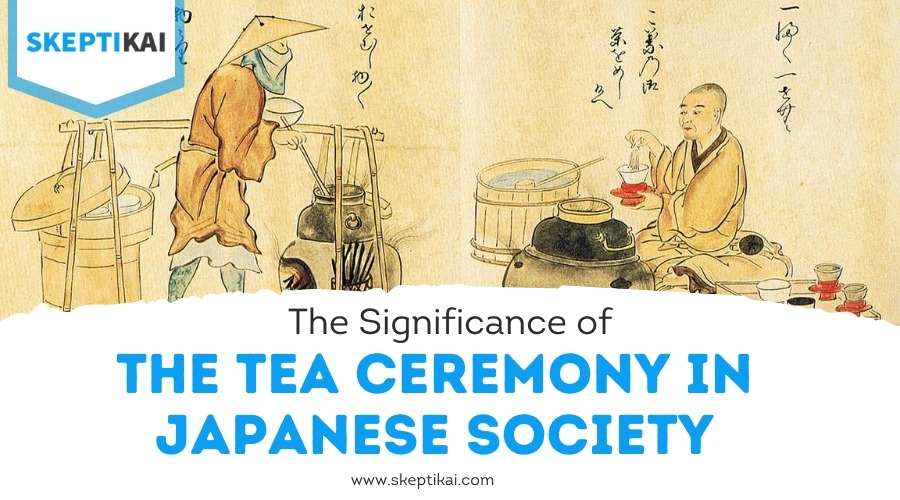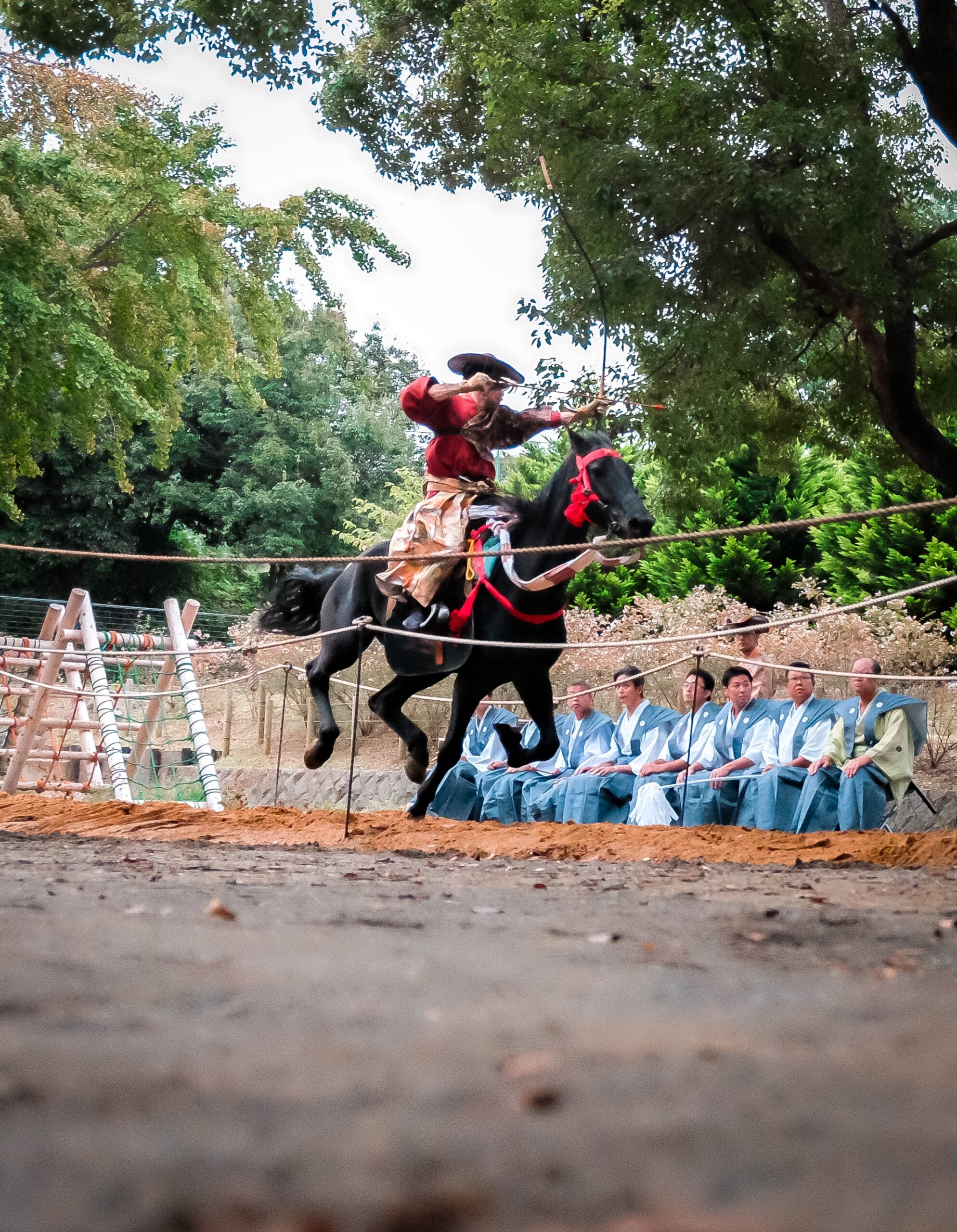How Did Christian Missionaries Influence Japanese Society and Culture?

Christian missionaries brought Western religious teachings, art, and values to Japan starting in the mid-16th century. They didn't just spread Christianity but also facilitated cultural exchange through language, art, and education. Missionaries introduced Western art and literature, reshaping Japan's visual and cultural landscape. Their efforts laid foundations for educational and health reform, particularly during the Meiji Restoration, promoting concepts like human rights and social welfare. Despite facing persecution, their influence endured, evident in customs like Christmas celebrations and Western-style weddings. If you're curious about the depth of their legacy, there's more to unravel in this enthralling historical narrative.
Arrival of Missionaries in Japan
When Christian missionaries initially set foot in Japan in the mid-16th century, they were stepping into a land both mysterious and unfamiliar. You can imagine the atmosphere of curiosity and caution that must've surrounded their arrival. Their primary interactions with the Japanese were marked by a mutual sense of wonder but also skepticism. These newcomers brought with them not only religious teachings but also Western ideas and customs, which were alien to the local populace. At the same time, the missionaries encountered a deeply rooted spiritual tradition centered around kami worship, which influenced daily life and culture. This added complexity to their mission as they navigated a society rich in its own beliefs and practices.
As you navigate through these early encounters, you notice the initial challenges missionaries faced. Language barriers stood as a formidable obstacle. Without a shared language, conveying complex theological concepts was incredibly difficult. Additionally, cultural differences led to misunderstandings, as Japanese society operated on principles and norms quite different from those of the missionaries' homelands. Political dynamics also posed a significant hurdle. Japan was divided into numerous feudal territories, each governed by powerful daimyo. Convincing these leaders of their peaceful intentions wasn't easy, and securing their favor was essential for survival and influence. Despite these challenges, the missionaries' persistence in building relationships laid the groundwork for their future endeavors in Japan.
Early Successes and Conversions
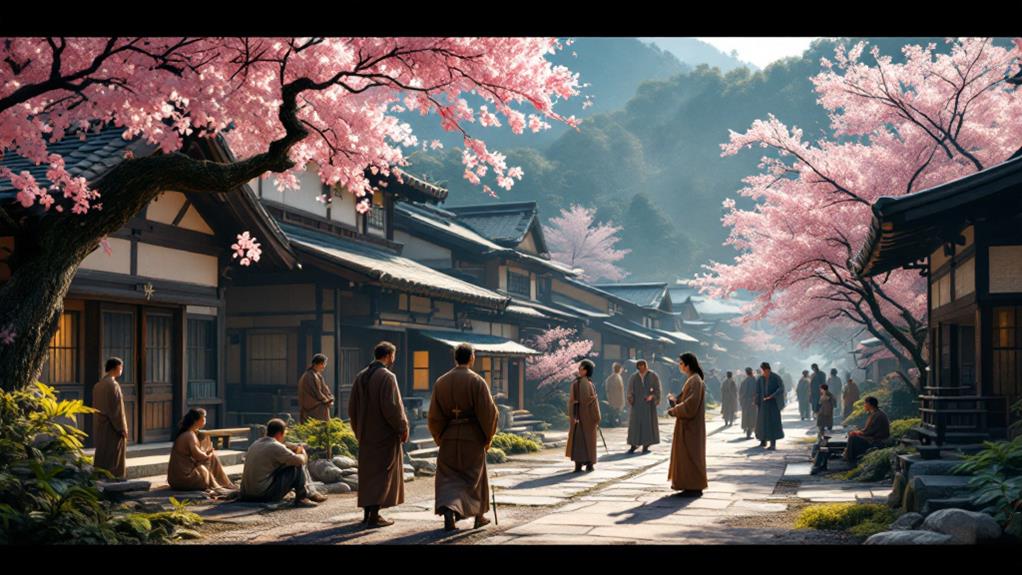
The resilience of the missionaries soon began to bear fruit as they achieved their initial successes in conversions. During these early encounters, the missionaries employed effective conversion strategies, focusing on understanding and engaging with the local culture. By learning the Japanese language, they could communicate more effectively, establishing trust and rapport. Their willingness to respect and adapt to Japanese customs allowed them to integrate into the communities they sought to influence. In addition to their religious efforts, missionaries introduced educational systems that included core values emphasizing respect and discipline, which resonated with Japanese society. You might find it interesting that the missionaries often used education and healthcare as entry points to introduce Christianity. By establishing schools and hospitals, they provided valuable services, which garnered goodwill among the locals. These efforts made the Christian message more accessible and appealing to those initially skeptical. The missionaries also targeted influential figures within society, hoping that their conversion would inspire others to follow suit.
In these early encounters, the missionaries' determination and strategic approach led to the baptism of thousands, including members of the samurai class. Their success lay in adapting their message to resonate with the local population's beliefs and values. Through patience and perseverance, they laid the groundwork for a Christian presence in Japan that still endures.
Cultural and Educational Exchanges

Missionaries in Japan didn't just focus on conversion; they actively engaged in cultural and educational exchanges that enriched both societies. You might be surprised to learn how these exchanges fostered a lively dialogue between the East and the West. Through language exchange, missionaries and Japanese locals learned each other's languages, opening doors to deeper understanding and cooperation. They didn't stop there—culinary influence was another delightful outcome, as foreign ingredients and cooking techniques introduced new flavors to Japanese cuisine.
Missionaries also established educational institutions that became centers for knowledge and growth. These schools provided a space for art collaborations, where Japanese and Western art forms influenced each other, leading to unique creations. Philosophical dialogue thrived as missionaries and scholars engaged in discussions, enriching both Japanese thought and Christian theology.
Here are some key impacts:
- Literary contributions: Missionaries translated Western literature into Japanese, broadening the cultural horizon.
- Scientific advancements: They introduced Western scientific methods, sparking curiosity and innovation.
- Social reforms: Missionaries advocated for changes that improved healthcare and social welfare.
These exchanges left a lasting impact on Japanese society, blending cultures and ideas in ways that are still evident today.
Introduction of Western Art
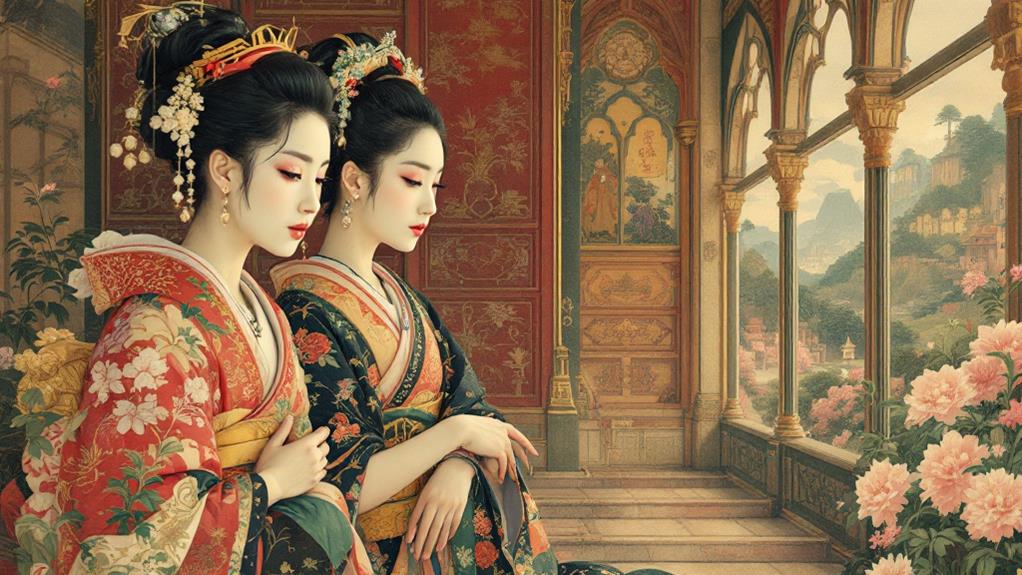
Artistic exchange took center stage as Western art made its way into Japan, reshaping the visual landscape. You could see the emergence of new artistic techniques that blended Western styles with traditional Japanese aesthetics. This fusion introduced elements such as perspective and chiaroscuro, which were relatively new concepts to Japanese artists. Missionaries, with their deep-rooted knowledge of Western art, played a significant role in this cultural exchange.
You'd find that religious symbolism quickly became a focal point in this artistic transformation. Christian missionaries used art not only as a medium of cultural exchange but also as a tool for spreading Christian beliefs. Paintings and sculptures often depicted biblical stories and figures, subtly introducing Christian iconography to a society that was largely unfamiliar with such themes.
As you investigate this period, notice how these new influences didn't completely overshadow traditional Japanese art. Instead, they provided a new dimension, enriching it and offering artists a broader canvas of expression. Western art's introduction marked a significant chapter in Japan's artistic history, where creativity flourished and opened doors to cross-cultural dialogues that still resonate today.
Impact on Japanese Governance

Amidst the rich cultural exchanges sparked by Western art, you'll find a significant shift in Japanese governance due to the presence of Christian missionaries. Their arrival brought not just religious teachings but also new ideas that influenced the ruling systems of the time. Missionary policies often introduced fresh perspectives on governance, blending Western administrative concepts with local customs. These changes prompted Japanese leaders to contemplate new methodologies and approaches within their own government structures.
As the missionaries interacted with local authorities, they encouraged government reforms that emphasized education and social welfare. They introduced new schools and hospitals, which weren't just religious establishments but also served as platforms for broader societal change. The missionaries' advocacy for these institutions led to increased importance on public services, encouraging leaders to rethink how government resources were allocated.
The impact of Christian missionaries on Japanese governance can be summarized through:
- Educational Influence: Pushed for reforms in education, leading to the establishment of schools.
- Healthcare Initiatives: Encouraged the development of hospitals and healthcare systems.
- Administrative Changes: Introduced Western concepts that influenced local policies.
These interactions laid the groundwork for future transformations within Japan's governance, leaving a lasting legacy.
Periods of Persecution
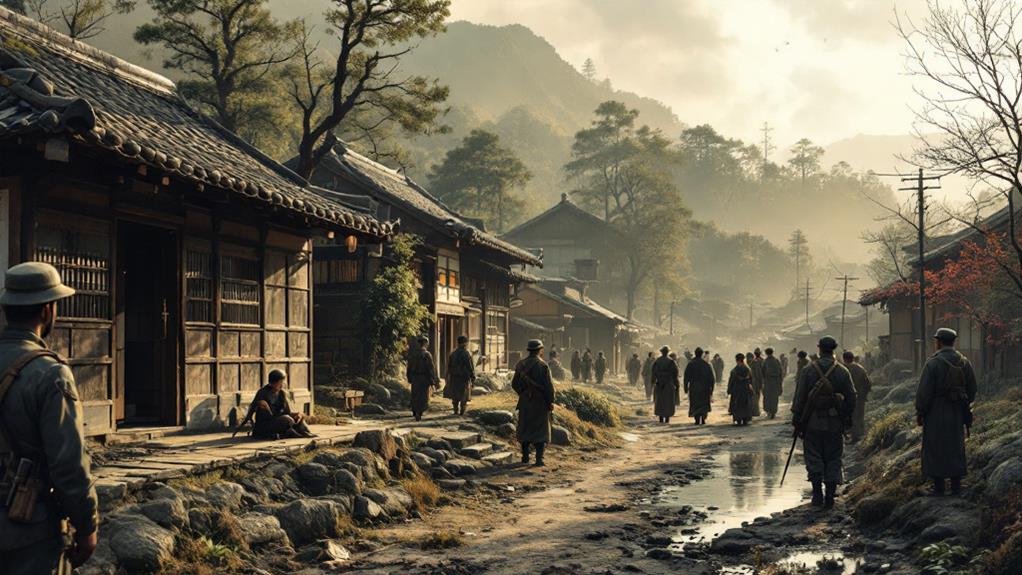
Japanese history witnessed multiple periods of persecution against Christian missionaries and their local converts, reflecting a complex relationship with the foreign religion. You might find it shocking how the Tokugawa shogunate, in particular, viewed Christianity as a threat to their power and social order. They feared that the growing influence of Christian missionaries could undermine traditional Japanese beliefs and lead to political instability. As a result, they implemented harsh policies of Christian persecution, aiming to root out the religion and deter its spread.
In response, missionaries showed remarkable resistance, often going underground to continue their work. They risked their lives to maintain their faith and help their converts. You'll see that their resistance wasn't limited to just spiritual efforts; they also employed strategies to outsmart authorities, such as using hidden symbols and secret gatherings. Despite the government's attempts to suppress Christianity, many Japanese converts remained steadfast in their beliefs.
This period of persecution left a significant mark on Japanese society, creating a narrative of resilience and resistance among Christians. It also set the stage for how Christianity would be viewed in Japan for years to come, balancing between acceptance and skepticism.
Long-term Cultural Integration
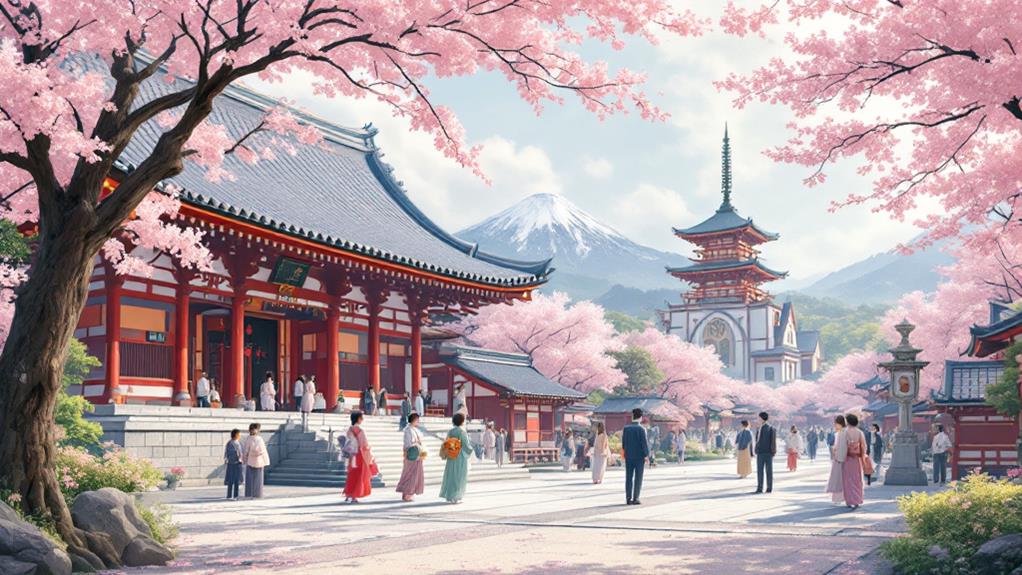
The path of Christianity in Japan didn't end with persecution; instead, it evolved into a story of cultural integration. Even after facing severe restrictions, Christianity found subtle ways to weave itself into the fabric of Japanese society. You can see this through cultural assimilation and religious syncretism, where elements of Christianity blended with native practices and beliefs. Over time, Christian customs merged with Japanese traditions, creating a unique cultural tapestry.
Consider the following ways this integration manifested:
- Art and Architecture: Christian influences appeared in Japanese art and architecture, with churches incorporating local styles and Christian symbols finding their way into traditional crafts.
- Language and Literature: Christian themes and stories became part of Japanese literature, influencing writers and poets who examined these narratives in their works.
- Festivals and Celebrations: Certain Christian festivals, like Christmas, were adopted and adapted into Japanese culture, celebrated with a distinct local flavor.
These blendings didn't just shape personal beliefs but also contributed to a broader cultural assimilation. While Christianity didn't become the dominant religion, its presence is undeniable. You can see its subtle influence in multiple aspects of modern Japanese life, illustrating the power of long-term cultural integration.
Influence During Meiji Restoration
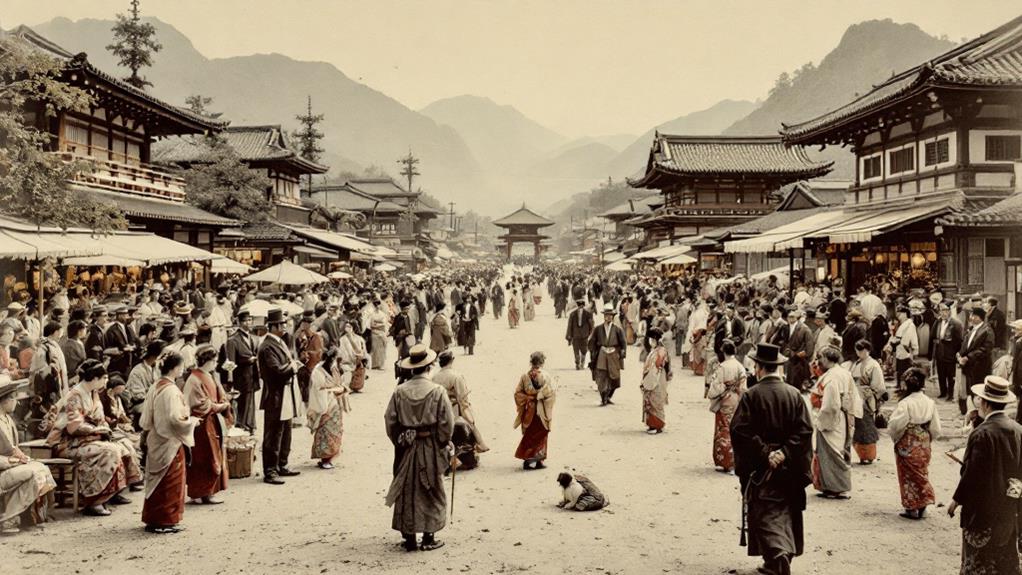
During the Meiji Restoration, a transformative period in Japanese history, Christianity played a significant role in shaping numerous aspects of society. Missionary strategies focused on education, healthcare, and social reforms, aiming to modernize Japan in line with Western principles. You'd see missionaries establishing schools and hospitals, which provided both practical skills and moral teachings. These institutions became the nucleus for new ideas and practices, fostering a more progressive outlook among the Japanese populace.
Missionaries didn't just spread religion; they introduced concepts like human rights and gender equality, aligning well with the Meiji government's desire to strengthen the nation. They advocated for social reforms, pushing for changes in traditional customs that hindered progress. You might notice how these efforts helped in abolishing practices like infanticide and promoting women's education.
Legacy in Modern Japan

Christianity's legacy in modern Japan manifests in diverse subtle yet profound ways. You can see its influence on the nation's acceptance of religious pluralism, where different beliefs coexist relatively peacefully. This environment encourages the exchange of ideas and traditions, enriching Japanese society. Additionally, Christian teachings have contributed to shaping social ethics, emphasizing compassion, charity, and social justice. These values resonate within many Japanese communities, informing actions and policies aimed at improving societal well-being.
In everyday life, the impact of Christianity is evident even if not immediately obvious. Consider the following:
- Christmas Celebrations: Although Christmas isn't a traditional Japanese holiday, it's celebrated with enthusiasm, reflecting a blend of cultural elements.
- Educational Institutions: Many prestigious schools and universities rooted in Christian principles continue to nurture students with a focus on holistic development.
- Wedding Ceremonies: Western-style church weddings are popular, symbolizing a fusion of tradition and modernity.
In a society that values harmony, Christianity's legacy complements other belief systems, fostering an inclusive culture. This religious pluralism improves community dynamics, allowing people to draw from diverse ethical frameworks. As Japan continues to evolve, these influences remain integral to its social fabric.

